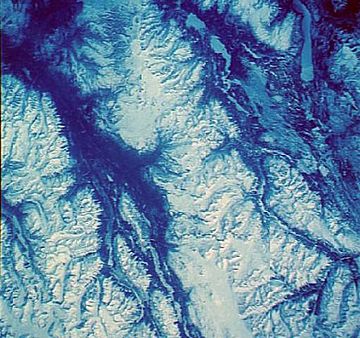Spectrum Range facts for kids
Quick facts for kids Spectrum Range |
|
|---|---|

Satellite photo of the Spectrum Range
|
|
| Highest point | |
| Peak | Yeda Peak |
| Elevation | 2,430 m (7,970 ft) |
| Geography | |
| Country | Canada |
| Province | British Columbia |
| Parent range | Tahltan Highland (southwestern Stikine Plateau) |
| Geology | |
| Orogeny | Volcanism |
| Age of rock | Pliocene-to-Holocene |
| Type of rock | Shield volcano |
The Spectrum Range is a group of mountains in northwestern British Columbia, Canada. It's part of the Tahltan Highland area. This mountain range is located about 20 kilometers west of the Stewart-Cassiar Highway. You can find it south of Mount Edziza and north of the Arctic Lake Plateau.
The Spectrum Range is special because it's located inside Mount Edziza Provincial Park. Unlike some other mountain ranges nearby, it doesn't have a lot of glaciers. Getting to the Spectrum Range is an adventure! There are no roads, so you can only reach it by hiking or by helicopter.
Why Is the Spectrum Range So Colorful?
The Spectrum Range gets its name from its amazing, bright colors. These colors come from special minerals found in the rocks that make up the mountains. It's similar to the Rainbow Range and Itcha–Ilgachuz Ranges further south, which also get their names from their colorful rocks.
How the Mountains Were Formed
The Spectrum Range is actually made up of four large stratovolcanoes. A stratovolcano is a tall, cone-shaped volcano built up by many layers of hardened lava, ash, and other volcanic rock.
Most of the Spectrum Range is a lava dome sitting on top of an older shield volcano. A lava dome is a round, steep-sided mound formed by very thick lava that piles up around a vent. A shield volcano, on the other hand, has gentle slopes, like a warrior's shield lying on the ground.
These mountains were formed a long time ago, starting in the Pliocene period (about 5.3 to 2.6 million years ago). On its southwestern side, you can find cones that formed during the Pleistocene period (about 2.6 million to 11,700 years ago). Some of these cones formed subglacial (under ice) and others subaerial (on land). The northwest and southwest parts of the range also have Holocene pyroclastic cones and lava flows. The Holocene period is the most recent, starting about 11,700 years ago. Pyroclastic cones are small, steep hills made of volcanic rock fragments.
One of the youngest parts of this volcanic area might be a spot called The Ash Pit.
Volcanoes You'll Find Here
The Spectrum Range is home to several volcanoes, including:
- Nahta Cone
- The Ash Pit
- Mess Lake
- Outcast Hill
- Thaw Hill
- Source Hill
- Tadekho Hill
- Wetalth Ridge
- Exile Hill
- Spectrum Dome
- Little Iskut
- Yeda Peak


